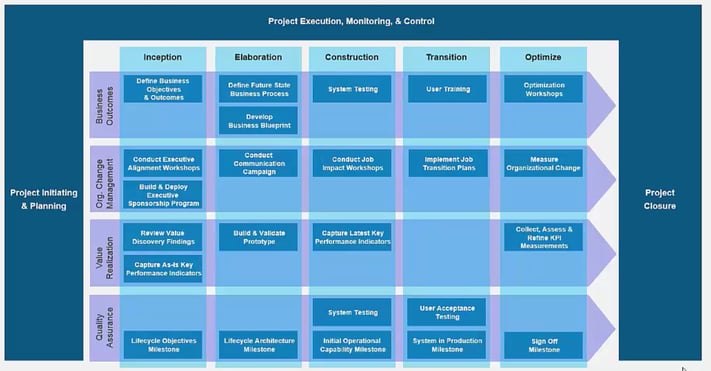There are big gaps between what the customer is expecting at the end of an ERP project and what the project is implemented to be aligned as outcomes. Why is it happening although the project is implemented in aligning with the project’s goals and objectives?
There are many reasons to explain why it could happen. However, there is a single answer which is always absolutely correct for any project. It is that the project is implemented and evaluated as cut-off deliverables, not as on-going outcomes which are developed across milestones of key & incremental benefits upon the pre-defined benefit road map.
Read more: The top 15 market-leading ERP software of 2016
So, why is it happening in the ERP projects? Let’s begin with the stage we are developing our business cases which are describing our business needs/ requirements. The stage should be done through a comprehensive roadmap in which each requirement is carefully mapped in the solution and hence it is demonstrated through a proof of concept. For a typical project, if the stage is qualified over 80% of 20% critical business cases, it can be put under consideration for the further stage – the implementation.

Hence, the 20% left will be bounded back into customisation during the process of gap analysis. Obviously, it is implemented to deliver 100% of business needs predefined during the business cases and/or business contracts/ state of works/ agreements.
However, as mentioned above, the project is not understood as on-going outcomes where the successful implementation is just a big achievable milestone which sets out a concrete stone to move on and in order to gain residual benefits under the predefined roadmap. It should be taken into accounts any concentration and contribution/ distribution of all related stakeholders in the ecosystem as it is now fully interdependent and integrated as a whole.
On the other hand, it is not proper care as previously mentioned and when the project is launched as go-live. It normally tends to get back into the environment where it used to be and there is less involvement into connections of related business processes. And we are more thoughtful of achievement though the progress is still going on.
Read more: Single ERP suite vs. multiple best-of-breed systems
If so, what is the ideal implementation approach a company should follow in order to have their own success? It is suggested below for our serious consideration:
1. Business cases
For what is the purpose of the implementation, the cases need to be scaled out in the context of the cost-benefit analysis. The benefit should be evaluated through as a process through its predefined roadmap and hence what is going to be implemented as understood objectives and goals must be mapped into its related work of products with predefined metrics/ KPIs how the outcomes will be best achieved.
2. Slow down and speed up
The process is put under proper care; it begins with how well the company understands about the project management? What are the company process asset (processes and procedures, company knowledge base) and environment factors (culture, structure and governance etc.,)?
In order to proactively answer in the mean of how the company is ready, it primarily triggers a process called the process of organisational project management maturity model in which you can map your current state of what you have had and what you are going to get prepared.
Then, based on the analysis, you sit down with the project team to pre-define what your project management processes are. It should be catered together with your implementation partner’s approach in order to have the best suitable approach to your company. It is actually the project management processes fallen into 5 groups:
- Initiating Project Group
- Planning Process Group
- Executing Process Group
- Monitoring & Controlling Group and
- Closing Process Group
These groups will be hence mapped respectively into its related knowledge area such as:
- Project Integration Management
- Project Scope Management
- Project Time Management
- Project Cost Management
- Project Quality Management
- Project Human Resource Management
- Project Communications Management
- Project Risk Management
- Project Procurement Management and
- Project Stakeholder Management
In each group, there are many specific processes in which you have to define what are Inputs, Tools & Techniques and Outcomes.
Inputs: what is direct and indirect into the related processes, it is including organisation process assets and environment factors
Tools & Techniques: what is professionally put in use to facilitate, evaluate, judge, review/ analyse to optimise rough/ raw data, information, outcomes into results which are qualified with KPIs, metrics of measurement and agreed upon by pre-defined project team and related stakeholders’ requirements/ needs.
Outcomes: what deliverables are must be reviewed, monitored, audited and controlled in aligning with each related KPIs, metrics of measurements predefined and agreed upon with the implementation partners.
Read more: Critical Failure Factors in ERP Implementation 
Delivery View (Infor Deployment Method)
3. Central Business Core Team
The team is primarily developed and hence integrated into the project team; the team is going to go with the project from the beginning to the ending. The team is carefully selected and qualified upon the requirements of the help desk support services, in the long run, it can built and indulged them into customer experience process and grown with competence and gained skills set.
The team is formed with very clear goals/ objectives, drilled down into each member’s goals/ objectives and/or career path and to-do-list. Then, the team is formed to facilitate its connection and collaboration.
Hence, the team is normed in order to perform its assigned works and then stormed to make sure that the team is able to understand and deliver its tasks as defined until the team can be able to perform their conformance works.
Read more: APS - a key integration for modern manufacturing ERP
There are many more techniques to build team largely due to our team building, motivation, open communication, influencing, negotiation, trust building, conflict management and coaching.
4. Project Stakeholder Management
This process is progressively elaborate to identify stakeholders, plan stakeholder management, manage stakeholder and control stakeholder engagement. The process is conducted in early of the approval of the project implementation and well performed during the project in order to manage expectations of related stakeholders which may not be fallen into project objectives and goals.
Together with accountable/ responsible engagements when the project comes to deliver its results, these stakeholder engagements may include but not limited to:
- Business process own
- Business process monitor/ support and control
- Business process improvement/ change (if required)
- Manage closely expectations of senior high management and
- Keep communicated with head of the central business core team for comprehensive supports
However, the process is not ended upon the completion of the project; it must be tailored to figure out who will be stakeholder in the post-implementation in the matrix of whom is power/ interest, power/ impact and impact/ influence into the long life of the project and will assist the project in getting sustainable benefits during and along with its pre-defined benefit roadmap previously mentioned in the beginning of this article.
Read more: [Infographic] - A comparison of Tier 1 ERP Vendors
5. Casual Business Users
In any company, there are still those who are considered as casual business users. They may or may not be a part resource of the project. They may or not be involved in any part of business contribution/ distribution.
However, they are still there! And as they are successful with many other projects which create and maintain their reputation and set out their functional impacts into any corners/ aspects of the project.
Frankly speaking, keep it simple that you need their perception and/or acknowledgement in order to smooth the project out. But how we do engage them as they are not defined by the human resource management of the project?
The only and possible way to analyse the matrix of the stakeholder stated above (considered them as an indirect stakeholder) and decide how you need to communicate with them, the focus may be these alternatives:
- Monitor
- Keep informed
- Keep satisfied or
- Manage closely
Last but not least, we have to do or integrate each to-do-list/ tasks of the project team into their reporting schema as they prior enter into the project, they are their functional staff.
Finally, a project is temporary endeavour undertaken to produce a work product, service or result. It is scheduled to solve problems and constrained by performance, time, cost and scope requirements and it is dedicated to those who are brave to face challenges and obstacles to turn into values of conformance works which are not previously performed or ever performed.
The outcomes are unturned stones for the company and the ones who take part in proactively to build sustainable growths of the company in business and in their career developments are benefited to be a member of the project.
Subscribe to our Blog to learn more about how to successfully implement an ERP project.
 English
English  Vietnamese
Vietnamese 


